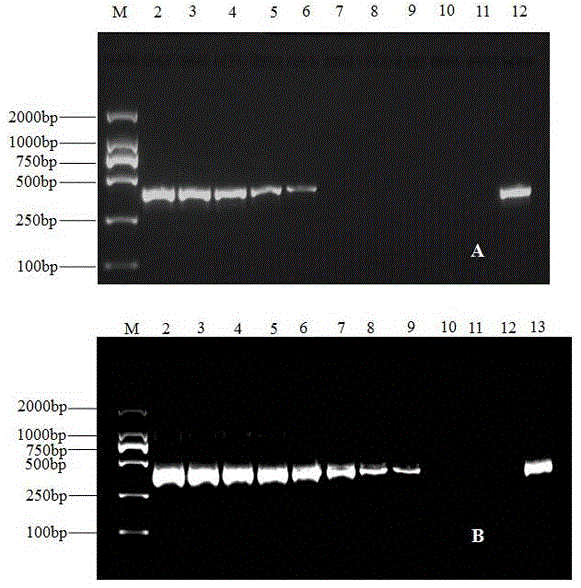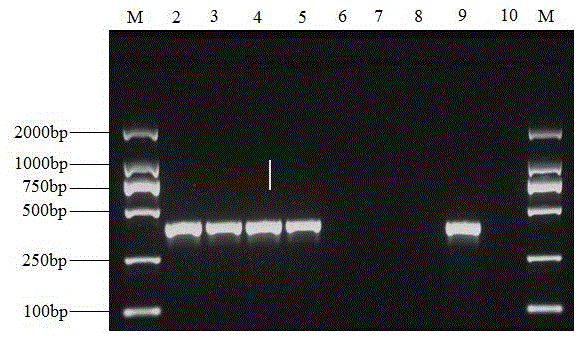Phomopsis asparagi molecular detection primer and fast detection method
A technology for asparagus stem blight and molecular detection, which is applied in the field of crop disease detection and biology, can solve the problems of low accuracy, long consumption and long life, and high requirements for identification experience, and achieves high practicability, high accuracy and wide applicability. Effect
- Summary
- Abstract
- Description
- Claims
- Application Information
AI Technical Summary
Problems solved by technology
Method used
Image
Examples
Embodiment 1
[0029] Example 1 Molecular Detection Primer Design and Establishment of Specific Molecular Detection Method for Stem Blight of Asparagus
[0030] 1. Extraction of Asparagus Stem Blight Genomic DNA:
[0031] Genomic DNA of 8 strains of Asparagus stem blight preserved in our laboratory was extracted by CTAB method, and the specific steps were as follows:
[0032] (1) Take 0.1g of mycelium powder in a 1.5mL centrifuge tube, add 900μL of 2wt.% CTAB extract, shake and mix with a shaker, bathe in 60°C water for 60min, and centrifuge at 12000r / min for 15min at room temperature;
[0033] (2) Take 700 μL of the supernatant, add an equal volume of phenol, chloroform, and isoamyl alcohol mixture (the volume ratio of each is 25:24:1), shake gently, and centrifuge at 8000 r / min for 10 min at room temperature;
[0034] (3) Take 500 μL of the supernatant, add an equal volume of chloroform and extract again, and centrifuge at 8000 r / min for 10 min at room temperature;
[0035] (4) Take 350 ...
Embodiment 2
[0053] Example 2 Specific Amplification of Stem Blight of Asparagus
[0054] 1. Using the CTAB method to extract the genomes of 2 strains of asparagus stem blight, asparagus brown spot, asparagus fusarium wilt and other pathogens of different crops (including lettuce sclerotinia, tomato cinerea, mushroom brown rot, and corn leaf spot) DNA.
[0055] 2. Use the DNA extracted from the test bacteria as a template for PCR amplification: 25 μL of PCR reaction system, including 2.5 μL of 10×PCR buffer, 2.0 μL of dNTPMixture with a concentration of 2.5 mmol / L, 0.15 μL of Taq enzyme with a concentration of 5 U / μL, 10 μmol 0.5 μL each of SF and SR per L, 1 μL of DNA template, add ddH 2 O to a total volume of 25 μL; PCR reaction conditions: 94°C pre-denaturation for 5 min; 94°C denaturation for 45 sec, 56°C annealing for 45 sec, 72°C extension for 45 sec, a total of 35 cycles; 72°C extension for 10 min; electrophoresis detection of amplified products.
[0056] 3. Specific amplificati...
Embodiment 3
[0058] Example 3 Sensitivity detection of primers of the present invention to asparagus stem blight
[0059] 1. Using the CTAB method to extract the genomic DNA of Asparagus stem blight;
[0060] 2. After the genomic DNA of the extracted asparagus stem blight bacteria is measured by a spectrophotometer, it is diluted with sterile ultrapure water, prepared into a series of concentrations, and set aside;
[0061] 3. Carry out routine PCR amplification with the prepared series of DNA as a template: 25 μL of PCR reaction system, including 2.5 μL of 10×PCR buffer, 2.0 μL of dNTPMixture with a concentration of 2.5 mmol / L, 0.15 μL of Taq enzyme with a concentration of 5 U / μL, 0.5 μL each of 10 μmol / L SF and SR, 1 μL DNA template, add ddH 2 O to a total volume of 25 μL; PCR reaction conditions: 94°C pre-denaturation for 5 min; 94°C denaturation for 45 sec, 56°C annealing for 45 sec, 72°C extension for 45 sec, a total of 35 cycles; 72°C extension for 10 min; electrophoresis detectio...
PUM
 Login to View More
Login to View More Abstract
Description
Claims
Application Information
 Login to View More
Login to View More - R&D
- Intellectual Property
- Life Sciences
- Materials
- Tech Scout
- Unparalleled Data Quality
- Higher Quality Content
- 60% Fewer Hallucinations
Browse by: Latest US Patents, China's latest patents, Technical Efficacy Thesaurus, Application Domain, Technology Topic, Popular Technical Reports.
© 2025 PatSnap. All rights reserved.Legal|Privacy policy|Modern Slavery Act Transparency Statement|Sitemap|About US| Contact US: help@patsnap.com



